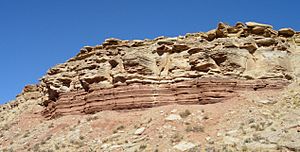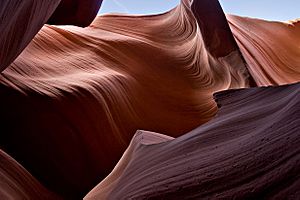Sedimentology facts for kids
Sedimentology is the study of tiny bits of rock, dirt, and sand called sediments. Think of sand on a beach or mud at the bottom of a lake. Scientists who study sedimentology are called sedimentologists. They look at how these materials are moved and laid down today. This helps them understand how rocks formed millions of years ago.
Sedimentologists learn about modern processes. Then, they use this knowledge to figure out how sedimentary rocks and their structures were made. Sedimentary rocks cover most of Earth's surface. They hold clues about our planet's long history. These rocks also contain the fossil record, showing us ancient life.
Sedimentology is connected to stratigraphy. Stratigraphy is the study of rock layers, called strata. It looks at how these layers are related to each other in space and time.
The idea that Earth's processes today are like those in the past is called uniformitarianism. This idea helps scientists understand how old rock features were formed. For example, they compare modern sand dunes to ancient ones found in rocks. This helps them figure out what past environments were like.
Contents
What are Sediments?
Sediments are small pieces of natural material. They are broken down from larger rocks by weathering. Weathering is like nature's way of crumbling rocks. After rocks break apart, these small pieces are moved by wind, water, or ice. This movement is called erosion. When the wind or water slows down, the sediments settle. This settling process is called deposition. Over long periods, these deposited sediments can get squashed and cemented together. This turns them into solid sedimentary rocks.
How Sedimentary Rocks Form
Sedimentary rocks are made from layers of sediment. These layers build up over time. As more layers pile on top, the weight presses down. This squeezes out water and air from the sediments. Minerals dissolved in water can then act like glue. They cement the sediment particles together. This process is called lithification. It turns loose sediments into hard rock.
Types of Sedimentary Rocks
There are different kinds of sedimentary rocks. They are grouped by what they are made of.
- Clastic rocks are made from pieces of other rocks. Examples include sandstone (made from sand) and shale (made from mud).
- Chemical rocks form when minerals dissolved in water crystallize. For instance, rock salt forms when salty water evaporates.
- Organic rocks are made from the remains of living things. Coal is an example, formed from ancient plants.
Studying Earth's Past Environments
Sedimentologists are like detectives. They use clues in sedimentary rocks to learn about ancient Earth.
- Ripple marks in rocks can show if there was water or wind.
- Mud cracks tell us that an area was once wet and then dried out.
- The size and shape of sediment grains can tell us about the energy of the environment. For example, large, rounded grains might mean a fast-moving river.
- Fossils found in sedimentary rocks show what kinds of plants and animals lived there.
By putting these clues together, scientists can reconstruct ancient landscapes. They can tell if an area was once a desert, a deep ocean, a river, or a swamp. This helps us understand how Earth has changed over millions of years.
Images for kids
See also
 In Spanish: Sedimentología para niños
In Spanish: Sedimentología para niños






